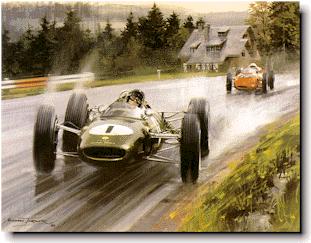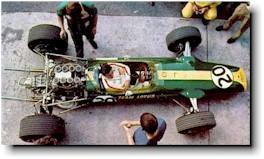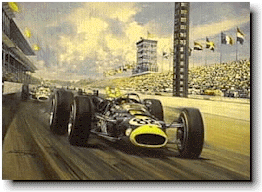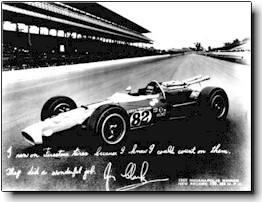 Jimmi Clark was born in Kilmany, in the county
of Fife to a Scottish farming family, roots that would stay with him the rest
of his life. He was the only son in a family of four daughters.
Jimmi Clark was born in Kilmany, in the county
of Fife to a Scottish farming family, roots that would stay with him the rest
of his life. He was the only son in a family of four daughters.  His early racing exploits were initially met by family
disapproval. He raced in rallies and other local races under the guidance of his
friend Ian Scott-Watson. Later he joined a team run by Jock McBain known as the
Border Reivers. In one of these races he drove a Lotus Elite against none other
than Colin Chapman. Chapman was very impressed by the young Scotsman and he would
keep an eye on this young lad. Ironically in 1959 the Border Reivers planned to
buy a single-seater Formula 2 Lotus for Clark but after watching Graham Hill lose
a wheel in a similar car, Clark decided that the Lotus cars were not safe and
that he would stick to sports cars for the time being. Eventually he graduated
to an Aston Martin which brought him to the attention of Reg Parnell, the factory
team manager. Aston Martin was planning on entering Formula 1 and after a test
he signed the young Scotsman. Clark had also by this time signed a Formula 2 contract
with Colin Chapman's Lotus team. Aston Martin's Formula 1 car was a disaster and
the factory decided to abandon its efforts. In Formula 2 Clark enjoyed immediate
success and when the Aston Martin drive failed to materialize, Clark signed on
with with Lotus for Formula 1 as well.
His early racing exploits were initially met by family
disapproval. He raced in rallies and other local races under the guidance of his
friend Ian Scott-Watson. Later he joined a team run by Jock McBain known as the
Border Reivers. In one of these races he drove a Lotus Elite against none other
than Colin Chapman. Chapman was very impressed by the young Scotsman and he would
keep an eye on this young lad. Ironically in 1959 the Border Reivers planned to
buy a single-seater Formula 2 Lotus for Clark but after watching Graham Hill lose
a wheel in a similar car, Clark decided that the Lotus cars were not safe and
that he would stick to sports cars for the time being. Eventually he graduated
to an Aston Martin which brought him to the attention of Reg Parnell, the factory
team manager. Aston Martin was planning on entering Formula 1 and after a test
he signed the young Scotsman. Clark had also by this time signed a Formula 2 contract
with Colin Chapman's Lotus team. Aston Martin's Formula 1 car was a disaster and
the factory decided to abandon its efforts. In Formula 2 Clark enjoyed immediate
success and when the Aston Martin drive failed to materialize, Clark signed on
with with Lotus for Formula 1 as well.
His first race for Lotus was at the Dutch Grand Prix in 1960, where he raced
in place of John Surtees who was still racing motorcycles at the time. His race
was pretty uneventful as he worked his way up to fifth place before he had to
retire with a seized gearbox. The next race was at Spa in Belgium. This was
the most dangerous course in Grand Prix racing, a 9 mile monster and in 1960
it took the lives of two drivers including Clark's teammate Alan Stacey.  Yet in spite of this Clark would manage to finish fifth
in his second Grand Prix. The next year was met with limited success and some
controversy. At the Italian Grand Prix, Clark's Lotus came into contact with
the Ferrari of Wolfgang von Trips. The Ferrari was propelled into the crowed
killing several spectators as well as the German driver, Germany's best hope
in decades. 1962 had top be better, and it was. In those days the calendar was
sprinkled with non-championship Formula 1 races and this season began with two
which Clark promptly won. Looking forward to the championship season opener
in Holland his hopes were dashed by another broken gearbox. A week later at
Monaco, a race that he would never win he was again betrayed by his machinery,
but this time it was an engine failure. After the year began with so much promise
Lotus was struggling to find some reliability. The Lotus 25 was a beautiful
race car if only it could finish a race that counted. The answer came in Belgium
at the track that Clark liked the least. Storming to victory Clark would win
this race four times running. Denis Jenkinson, the legendary journalist, discussing
his disdain for the World Championship and its bias towards reliability over
wins, declared that only one race should count, that race being Spa and whoever
won it should be declared the World Champion. Clark after a season long battle
lost the championship to Graham Hill when his car broke down while leading the
final race.
Yet in spite of this Clark would manage to finish fifth
in his second Grand Prix. The next year was met with limited success and some
controversy. At the Italian Grand Prix, Clark's Lotus came into contact with
the Ferrari of Wolfgang von Trips. The Ferrari was propelled into the crowed
killing several spectators as well as the German driver, Germany's best hope
in decades. 1962 had top be better, and it was. In those days the calendar was
sprinkled with non-championship Formula 1 races and this season began with two
which Clark promptly won. Looking forward to the championship season opener
in Holland his hopes were dashed by another broken gearbox. A week later at
Monaco, a race that he would never win he was again betrayed by his machinery,
but this time it was an engine failure. After the year began with so much promise
Lotus was struggling to find some reliability. The Lotus 25 was a beautiful
race car if only it could finish a race that counted. The answer came in Belgium
at the track that Clark liked the least. Storming to victory Clark would win
this race four times running. Denis Jenkinson, the legendary journalist, discussing
his disdain for the World Championship and its bias towards reliability over
wins, declared that only one race should count, that race being Spa and whoever
won it should be declared the World Champion. Clark after a season long battle
lost the championship to Graham Hill when his car broke down while leading the
final race.
During a break in action Lotus took the Grand Prix car to Indianapolis and
tested it on the famous speedway while the track was closed. He soon had the
car lapping at 140 mph.  The Americans who were in attendance that day were
catching a glimpse of the future. In 1963 Clark dominated the World Championship
winning an amazing 7 out of 10 races, garnering 7 poles in the process. At his
first race at Indianapolis he finished second to Parnelli Jones. The next year
was an up and down year with the championship being fought between Graham Hill,
Surtees and Clark. The final and deciding race in Mexico saw Hill out due to
a controversial collision with Surtees teammate Bandini. Clark was leading the
race until the last lap when his engine seized and the title fell to Surtees
and Ferrari. The championship in 1965 was again a duel between Clark, Hill and
Surtees, but a fourth driver rose to the challenge the leading trio. His name
was Jackie Stewart and the fellow Scot served notice that he would be a force
to reckon with in the future. This year it was Clark's turn at the top rung
and he included a win at Indianapolis for good measure. Leading the race for
190 laps out of 200 he left a lasting impression on his American rivals.
The Americans who were in attendance that day were
catching a glimpse of the future. In 1963 Clark dominated the World Championship
winning an amazing 7 out of 10 races, garnering 7 poles in the process. At his
first race at Indianapolis he finished second to Parnelli Jones. The next year
was an up and down year with the championship being fought between Graham Hill,
Surtees and Clark. The final and deciding race in Mexico saw Hill out due to
a controversial collision with Surtees teammate Bandini. Clark was leading the
race until the last lap when his engine seized and the title fell to Surtees
and Ferrari. The championship in 1965 was again a duel between Clark, Hill and
Surtees, but a fourth driver rose to the challenge the leading trio. His name
was Jackie Stewart and the fellow Scot served notice that he would be a force
to reckon with in the future. This year it was Clark's turn at the top rung
and he included a win at Indianapolis for good measure. Leading the race for
190 laps out of 200 he left a lasting impression on his American rivals.  The new 3-litre Formula introduced in 1966 led to a
down year for Lotus as they did not have an engine that was competitive. It
was not till the arrival of the Ford Cosworth DFV in 1967 that brought Lotus
back to the fore. Clark won at Zandvoort in the legendary engine's first start
yet it was too late in the season and Clark had to settle for 3rd place in the
World Championship. 1968 started with a win in South Africa, which allowed Clark
to surpass Juan-Manuel Fangio in Grand Prix victories. Sadly this was to be
his last win for he was killed in a Formula 2 race in Hockenheim that year.
A shy unassuming man his legend lives on as one of the very best and places
him amongst the giants of the sport Nuvolari, Fangio and Senna.
The new 3-litre Formula introduced in 1966 led to a
down year for Lotus as they did not have an engine that was competitive. It
was not till the arrival of the Ford Cosworth DFV in 1967 that brought Lotus
back to the fore. Clark won at Zandvoort in the legendary engine's first start
yet it was too late in the season and Clark had to settle for 3rd place in the
World Championship. 1968 started with a win in South Africa, which allowed Clark
to surpass Juan-Manuel Fangio in Grand Prix victories. Sadly this was to be
his last win for he was killed in a Formula 2 race in Hockenheim that year.
A shy unassuming man his legend lives on as one of the very best and places
him amongst the giants of the sport Nuvolari, Fangio and Senna.
ALL THE VICTORIES
| 1962 | Belgio Gran Bretagna USA |
| 1963 | Belgio Francia Gran Bretagna Olanda Italia Messico Sudafrica |
| 1964 | Belgio Gran Bretagna Olanda |
| 1965 | Belgio Francia Gran Bretagna Germania Olanda Sudafrica |
| 1966 | USA |
| 1967 | Gran Bretagna Olanda Messico USA |
| 1968 | Sudafrica |
© by Questo indirizzo email è protetto dagli spambots. È necessario abilitare JavaScript per vederlo.